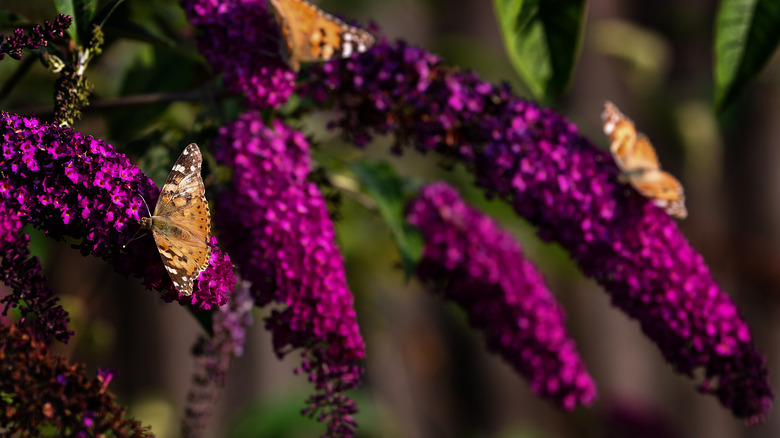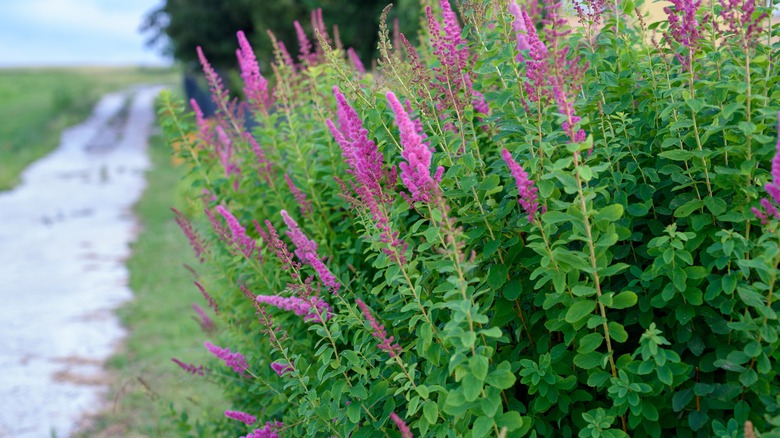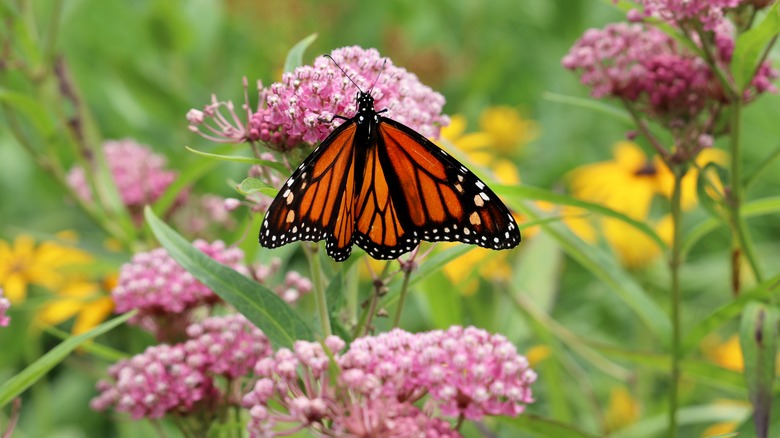Think Twice Before Growing A Butterfly Bush In Your Yard
Butterfly bushes are often sold by large garden centers and nurseries and are recommended as a great way to attract more pollinators, and butterflies in particular, to your yard. Butterflies indeed love butterfly bushes (hence the name) because they produce more nectar than most flowers. If you plant a butterfly bush in your yard, you will likely see butterflies visit the deep purple-colored cone-shaped flowers quite often. However, despite the bushes attracting butterflies and sporting pretty flowers, there's a good reason not to plant them in your yard: butterfly bushes are actually considered an invasive species in the United States and Europe.
In fact, this plant, scientifically known as Buddleia davidii, originated in China and was brought first to Europe and then to America for its beauty, ease of growth, durability, and early blooming season. While, to us gardeners, these qualities may seem like a good thing, they also help butterfly bushes out-compete native plant varieties. This, in turn, damages the ecosystem by decreasing biodiversity.
How butterfly bushes hurt the environment
Besides being better at reproducing and growing than many native plant varieties that attract pollinators, butterfly bushes are better at one important thing that makes all the difference — making nectar. According to the University of Maryland, this is a big problem because the butterfly bush's ability to produce more nectar makes it more attractive to pollinators. Therefore, these pollinators spend more time on the butterfly bushes and sometimes skip visiting native plants altogether. This makes it difficult for native plants to reproduce because pollinators are less likely to land on them and pick up their pollen.
Another way that butterfly bushes are bad for the native ecosystem is that they aren't appropriate caterpillar food. Per the National Wildlife Federation, most native plants that attract pollinators also serve as food for caterpillars to consume as they grow. However, because butterfly bushes are not native to the U.S., no caterpillar can eat the leaves on the plant. This creates a situation where butterflies will be attracted to your yard because of the butterfly bush but may be unable to find any suitable plant to lay their eggs on. This prevents butterflies from reproducing easily and, over time, hurts the overall population.
Native plants that are better than butterfly bushes
So, what can you plant in your garden that will help attract butterflies while also allowing them to lay eggs and become fat caterpillars? The answer is milkweed. While the name milkweed is not as attractive as the name butterfly bush, milkweeds are a group of native plants that butterflies, including monarchs, absolutely adore. Plus, the flowers on milkweed are just as colorful and beautiful as those on butterfly bushes. For tiny white flowers that grow in a bundle, you can plant snowy milkweed. For vibrant flowers, go with the orange butterfly milkweed or the light pink swamp milkweed.
If you are looking for something with those beautiful dark purple hues, you can step away from the milkweeds and go with an American beautyberry shrub. This plant grows in the form of a bush and contains clusters of beautiful magenta berries which are preempted by light purple flowers. Other great native pollinator plants include bee balm, goldenrod, black-eyed Susans, tickseed, and sweet pepperbush.


